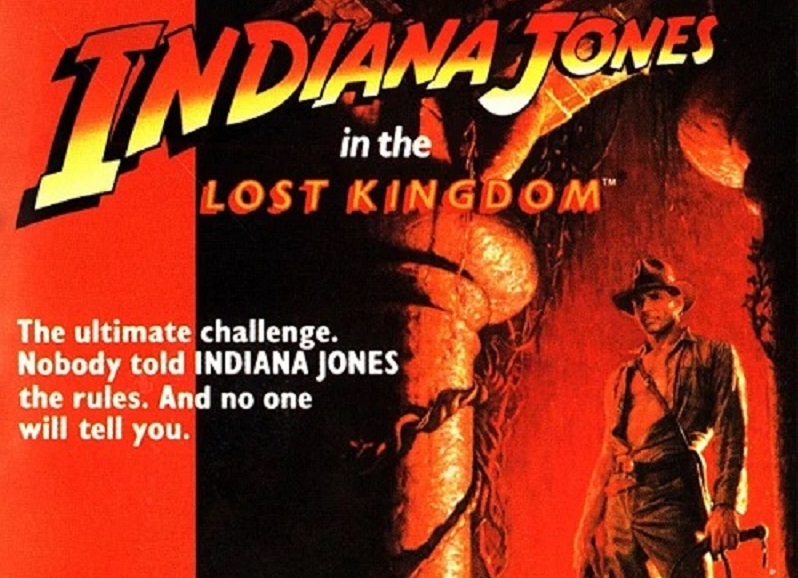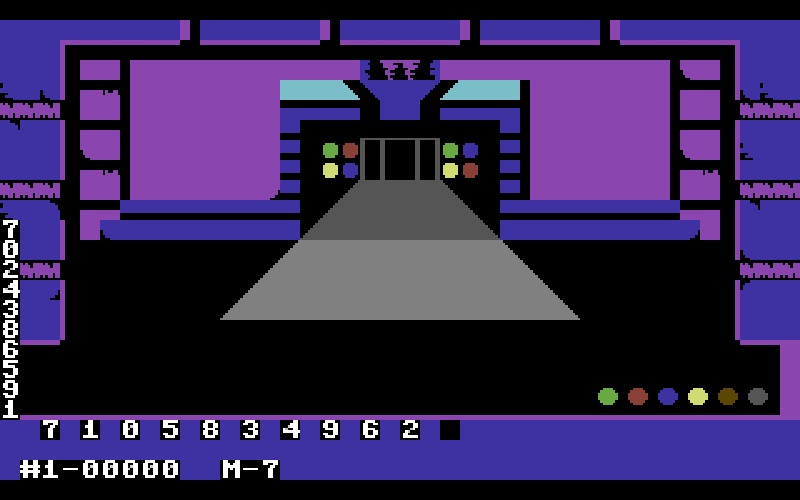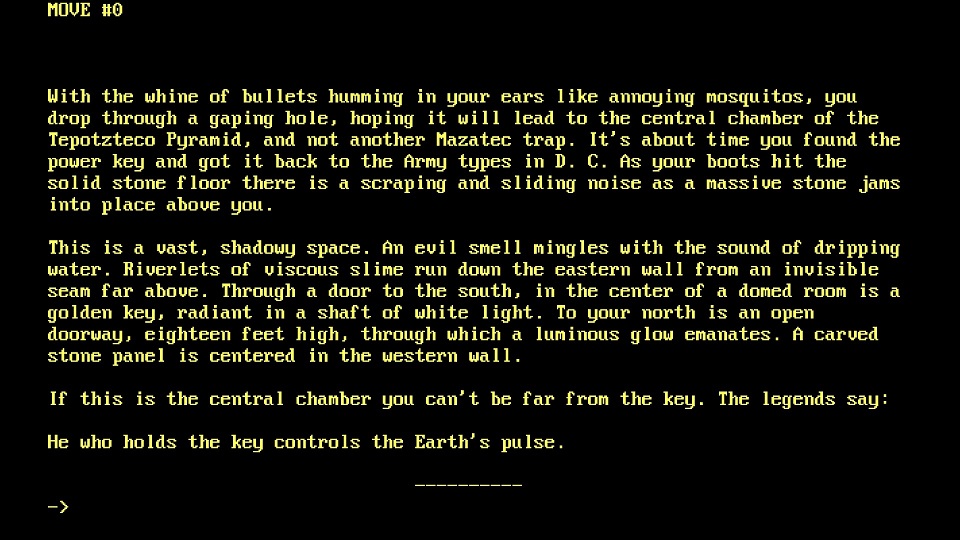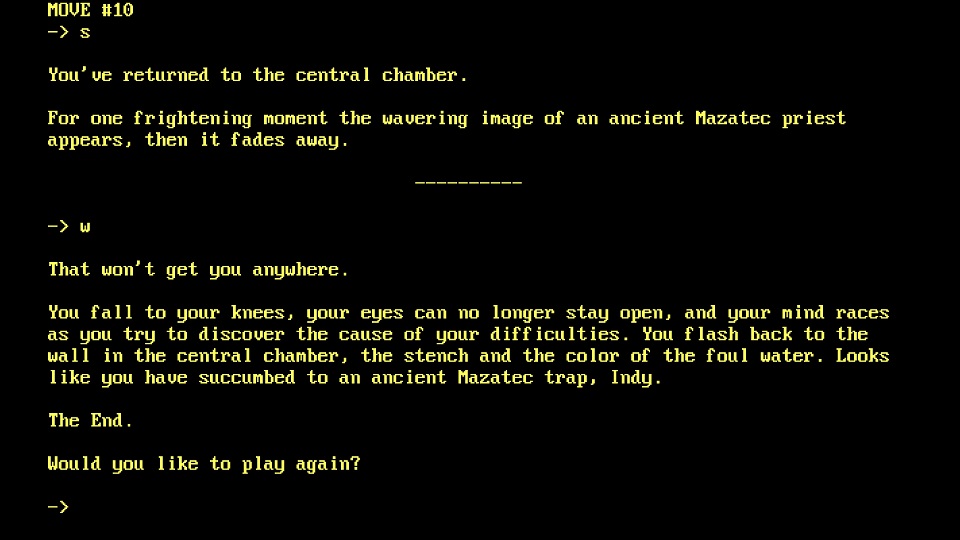Indiana Jones in the Lost Kingdom and Revenge of the Ancients
Indiana Jones in The Lost Kingdom
Commodore 64 - Mindscape, 1984
Indiana Jones in the Lost Kingdom is the first original Indy story outside of the movies. This was before Lucasarts time, and was developed for the Commodore 64. It’s frustrating and barely comprehensible, but its most egregious flaw is the use of “in” instead of “and” in the title, an outrageous offence to any Indy fan! This and Revenge of the Ancients are the only “In”diana Jones titles of any media that I can find evidence of.

The Lost Kingdom is a half puzzle, half action game published by Mindscape, a relatively big publisher of the time. The box art cites logical thinking and problem solving as selling points, boasting that the player will get no instructions “Nobody told Indiana Jones the rules. And no one will tell you.” The puzzle aspect of the game is evident from the outset, which are more brain teasers than video game puzzles. These mostly take the form of number or colour matching puzzles akin to the Mastermind board game, although some environmental puzzles are introduced later in the game. While Indy is running around with numbers attached to his head, you also have to avoid (or whip) a number of nasty creatures, or get through some slightly janky platforming to place the numbers or coloured balls in the correct place. It seems a slightly bizarre mish-mash of genres, and I assume quite satisfying in 1984 only if you’d just seen Temple of Doom and wanted to relive the scene where Indy put ASCII numbers into a waterfall.

In retrospect though, I can imagine a successful 2020s indie game (but not an Indy game) in this vein, mixing brain-training style puzzles while simultaneously trying to survive combat and platforming. If it wasn’t for the Indiana Jones License it may succeed as a curiosity.
However, reviews were middling to poor at the time, the puzzles and lack of instruction criticised for being obtuse, and now with the added layer of ageing graphics and controls, it’s verging on unplayable. This is where the frustration really sets in for me and I’m not a fan of pre-VGA graphics, which doesn’t help my patience with 80s games.
But perhaps there is an 80s Indy game that can avoid my distaste for old 16-colour graphics…
Indiana Jones in Revenge of the Ancients
PC/Mac - Mindscape, 1987
Like The Lost Kingdom, Revenge of the Ancients is an original Indiana Jones story. Unlike its predecessor, this time we have an actual story and location.
We are in Mexico, where we will return later in Indiana Jones and his Desktop Adventures, but perhaps in anticipation of that game's poor review scores for its graphics, this text adventure has none.

Text adventures, or Interactive Fiction, became popular in the early days of computing. Most computers were not able to produce computationally intensive graphics, so these games were told through text, with some decisions allowed by the user like slightly more complicated ‘choose your own adventure’ books. The computer will describe your situation, and the player responds with what they want to do. Depending on how complex the game was, it could understand a limited set of verbs and actions such as “go north” or even more complex sentences. The computer will then respond with the results of your actions, or describe the next scene.
IF games were around their peak when Revenge of the Ancients was released, but graphical games were really starting to become advanced, and the rise of home consoles such as the Nintendo NES saw popular demand for fancy looking games increase. The 90s saw IF games largely die out, as we moved on to graphical adventures using systems such as Lucasarts SCUMM. Now players could see the scene, and point and click on their beloved verbs instead of typing them. Eventually we get rid of the pesky words altogether in favour of conversation options or even objects icons such as in The Dig
There are three bullet points on the back of the box which make a few claims about this game, let’s have a look.

1. “Detailed prose that transports you to the setting”
You are in a race against time to stop the Nazi’s from recovering a mystical key which will unleash a dangerous power. This is a classic Indy setting, and a big benefit of text adventure games is the player’s imagination. Just like reading a book, perhaps one of the tie-in-novels,you can easily imagine Jones in the dark, musty chamber inside the pyramid in the opening scene, stone doors scraping closed as they trap you inside. The graphics in my imagination are much better than the primitive graphics of Indiana Jones and the Last Crusade: The Graphic Adventure if it’s inspired by good writing. The writing in Ancients is very evocative and appropriate to Indy, so bullet point number one gets a pass.
2. ”Fully developed characters that respond realistically”
There are a few characters other than Indy in Revenge of the Ancients including some old friends. You barely interact with them, they serve more as part of Indy’s story rather than characters in their own right. There are no real conversations or much communication at all apart from exposition from the descriptive text. The inevitable Indiana Jones love interest doesn’t serve much purpose other than to be a damsel in distress. Bullet point number 2 is a fail.
3. “Advanced techniques that allow you to give commands in plain English”
With the library of Indiana Jones games’ containing some of the most well-designed point-and-click adventure games ever made it’s slightly unfair to compare Revenge of the Ancients. It’s much more frustrating than its graphical counterparts, its ‘puzzles’ are like pixel hunting in a point-and-click, except with words. This wouldn’t be too bad, but your actions are time-limited. If you explore too much or try too many commands (parseable or otherwise) then it’s game over.
My practice (and strong recommendation) for playing older games is to use walkthroughs whenever you come up against a road-block, and a walkthrough is absolutely crucial with Revenge of the Ancients. Not being well versed in IF, it would have been easier could I have found a manual or list of allowed verbs, but without the ability to quickly search the internet, it must have been even more frustrating in 1987. I understand that some IF games were quite forgiving in terms of commands, this one is not.
Sorry bullet point number three, that is a fail.

It’s no Character.AI in terms of interpreting input. One of many initial uses for the new Large Language Model (LLM) Artificial Intelligence systems of the 2020s is to dynamically generate natural language stories like some sort of robot Dungeon Master. In fact one of the first examples was precisely this, 2019’s AI Dungeon, using an early LLM to guide player’s Dungeons & Dragons style experiences. Many services like Character.AI tend to have issues with, or even a focus on, lewd content, which is a shame. However they have trained many LLMs to generate stories on the fly with input from the user after each chunk of text, asking them what they want to do next.

Apart from the many ethical implications of this such as threatening the livelihood of artists as well as issues such as what this means for copyright, LLMs in 2023 still have many limitations. They are not always well written, often falling back on the same words, phrases or themes. Most obviously, sometimes they don’t make any sense at all or do something which doesn’t fit with their user’s expectations. They can often be tricked into going down a particular direction, often unseemly ones, deliberately or otherwise on the part of the user. Most importantly, they can’t construct a story with a beginning, middle and end, or are even capable of any notion of what you might find satisfying in a story’s conclusion. You’re unlikely to get much payoff in your ending, or perhaps any ending at all. In the future maybe some more matured LLM technology will replace Hal Barwood with a giant Atlantean-style robot, but I think there will always be a place for inventive and resourceful humans.
No one knows what LLMs mean for the future, but looking at it purely in terms of input and output for interactive fiction, it’s quite exciting. The reactivity to the user is incredible, and the risk of getting killed just because you made a typo is far less than in Revenge of the Ancients.
Well, at least until they build Skynet.
